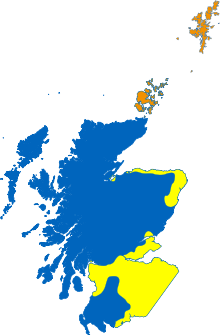Gàidhealtachd
The Gàidhealtachd [ kɛːəlˠ̪t̪əxk ], German: Gälentum, sometimes also called A 'Ghàidhealtachd , usually refers to the Scottish highlands and in particular to the Scottish Gaelic language and culture of the region. The corresponding Irish-Gaelic term Gaeltacht refers to an Irish-Gaelic-speaking region with a special legal status for official language use with regard to English and Gaelic. The Scottish term the Gaeltacht areas of Nova Scotia ( Nova Scotia ) in Canada a.
The term A 'Ghàidhealtachd does not fully coincide with the geographical region of the Scottish Highlands as it is primarily related to language rather than geography. In addition, large parts of the highlands no longer have a significant Gaelic-speaking population, and the Germanic languages Scots or English are spoken in some areas of the Scottish Highlands : Caithness , Cromarty , Grantown-on-Spey , Campbeltown and others. On the other hand, some Gaelic-speaking communities are outside the traditional Scottish highlands, such as Argyll and Bute and the Outer and Inner Hebrides . For this reason, the Gàidhealtachd includes not only the Gaelic-speaking areas of Scotland, but also Nova Scotia and other parishes in Canada such as Glengarry County , where Scottish Gaelic is still spoken by a large part of the population today.
The terms Galldachd and Gall refer to all non-Gaelers and are mostly used to refer to the inhabitants of the Lowlands . At this point, however, it should be noted that the Hebrides are also known as Innse Gall due to the historical presence of the Vikings .
history
Until the 18th century, the Gàidhealtachd still covered large parts of what is now Scotland north of the Firth of Forth and Galloways , with the exception of the Orkney and Shetland Islands , which never belonged to the Gaelic-speaking area. Gaelic place names show that this was originally a Celtic settlement area: Dundee from Gaelic Dùn Deagh , Inverness from Inbhir Nis , Argyll from Earra-Ghàidheal , Galloway from Gall-Ghaidhealaibh and probably Stirling from Sruighlea (the etymology is unclear, however). Gaelic speakers who are now considered English speakers include George Buchanan from Stirlingshire and Robert the Bruce and Margaret McMurray from Galloway and Ayrshire .
Historical developments meant that, through the cultural influence of the Scots- speaking royal court in Edinburgh and the establishment of large-scale trading towns in the southern and eastern parts of Scotland, the Gàidhealtachd massively affected the present-day region of the Western Isles (Outer Hebrides, the northwestern highlands with the Isle of Skye , Kyle of Lochalsh and Argyll and Bute ). Small groups of speakers can also be found in Glasgow and Edinburgh.
Another reason for the decline of Scottish Gaelic is unfavorable demographic trends. Not so long ago, many Gael lived in the rural highlands. Due to the expulsions - Highland Clearances - in the 18th and 19th centuries and the emigration to North America, the number of Gaelic speakers steadily decreased. Many young people who still speak the Gaelic language see their future in the English-speaking cities in southern Scotland and in England or North America.
Modern Gàidhealtachd
Thanks to the Internet and other modern communication technologies, the Scottish-Gaelic diaspora are increasingly able to come into contact with one another and thus use the language outside of the closed language area. Many interested laypeople from a wide variety of countries also have access to current Scottish Gaelic original texts. There are also a large number of language courses online that can be used via the YouTube platform , e.g. B. "Speaking our Language" which is also broadcast daily in Scotland by the BBC Alba . Scottish-Gaelic pop groups like Mànran , Capercaillie or Runrig as well as singers like Julie Fowlis also help the Gaelic language to gain international fame and reputation. The same can be said about the medium of film. The film " Seachd - The Inaccessible Pinnacle", the first 88-minute feature film in the Scottish Gaelic language, as well as films in which the Scottish Gaelic language is used in selected scenes, also help the endangered idiom to gain more prominence. Examples of this are the Walt Disney film “ Merida - Legend of the Highlands ”, “ Rob Roy ” or “ The Eagle of the Ninth Legion ”.
Canadian Gàidhealtachd
Scottish Gaelic is also spoken in the communities on Cape Breton Island and south of it by the descendants of Scottish immigrants, also in Glengarry County in what is now Ontario , Prince Edward Island and Newfoundland . However, Irish Gaelic is spoken in Newfoundland .
See also
Individual evidence
- ↑ http://www.dictionary.com/browse/gaidhealtachd . Retrieved August 18, 2016
- ↑ http://www.dictionary.com/browse/gaeltacht . Retrieved August 18, 2016
- ↑ after David Ross: Scottish Place-Names . 1st edition. Birlinn, Edinburgh 2001, ISBN 1-84158-173-9 , pp. 24 ff . (English).


